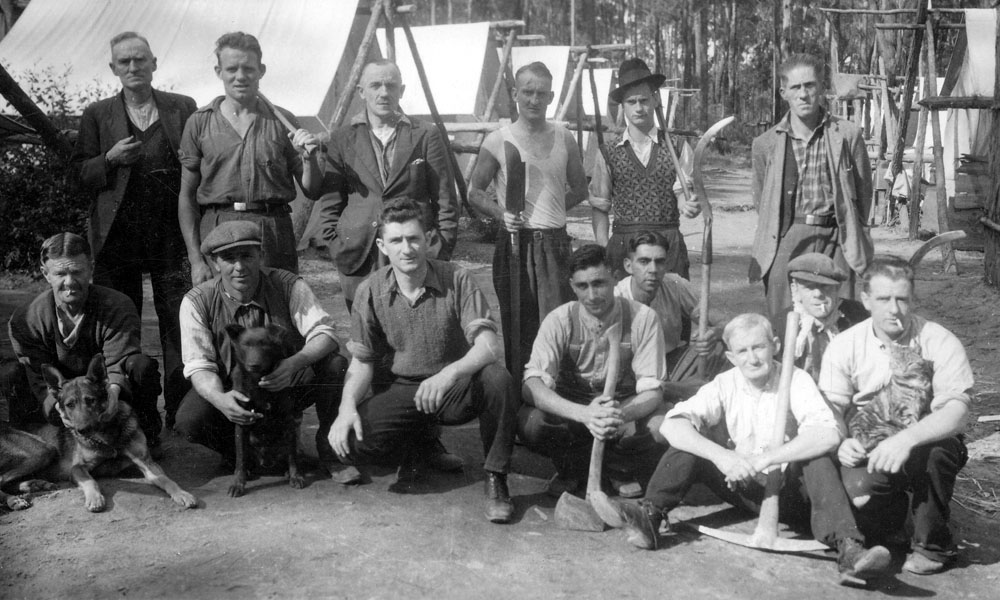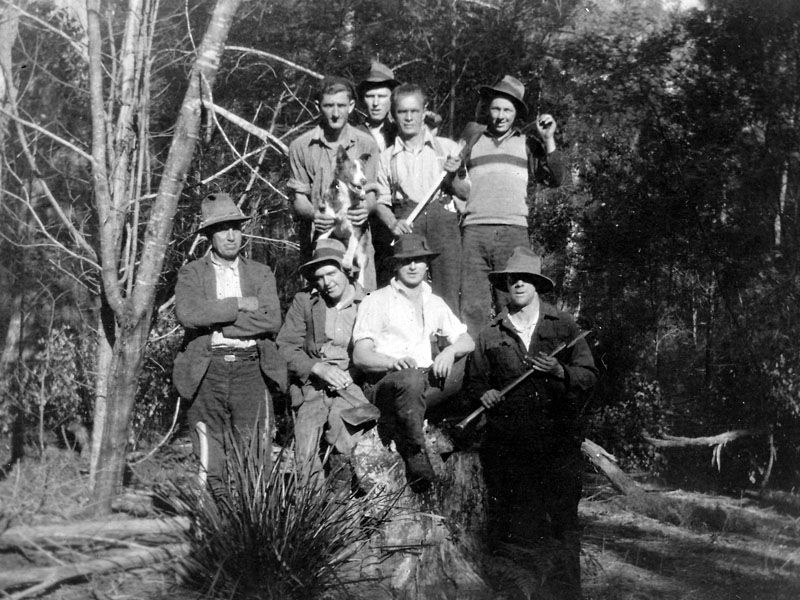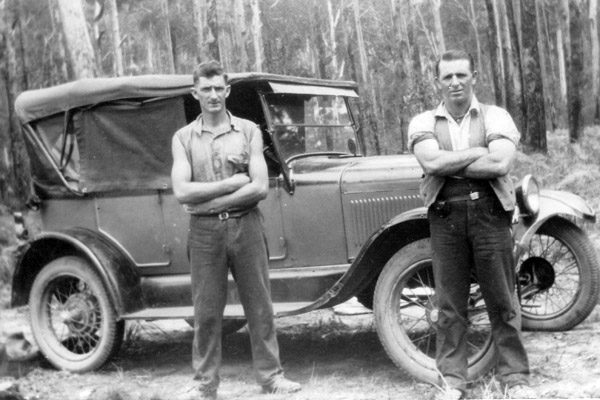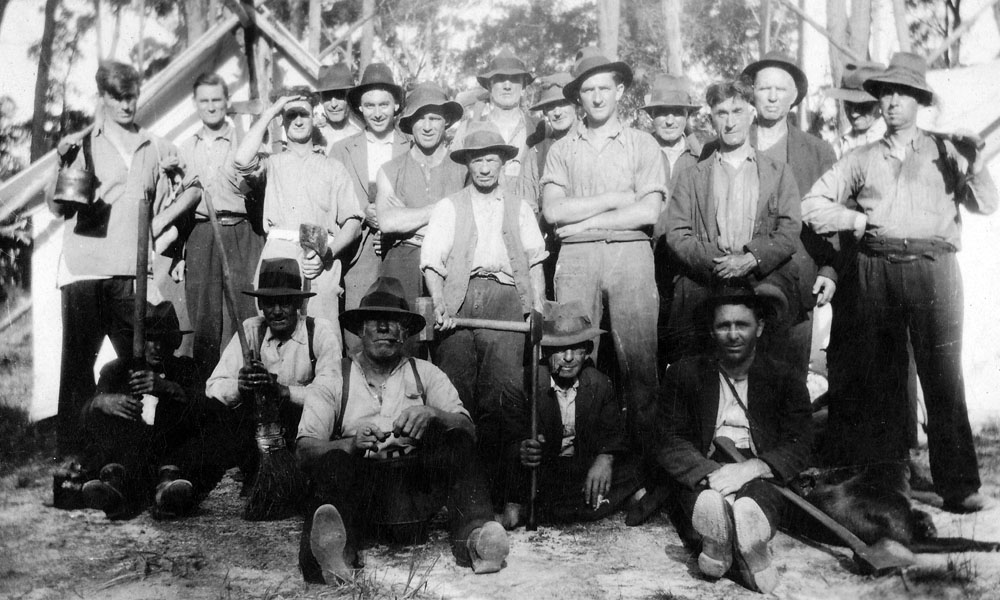Echoes From the Past
Charles G Pettman
Forest Overseer
Nowa Nowa Forest District
This is a direct copy of Charles’ story but with a light edit to improve readability.
I first started working for the Forests Commission at the Burnt Bridge on the old highway at Toorloo Arm in the relief camp days in the early thirties. In the big Depression men were unable to find work in Melbourne; the Commission employed men to do silvicultural work. They were camped in tents and when they arrived we had a hot meal ready for them, enough kero in lanterns for one night, beds were two poles on forked sticks and two chaff bags. They knew what they were entitled to before they left Melbourne and they would check camp to see if everything was there; if not they would send a rep. to Forest Officer Freddie Kerr at the time and they would soon get what they were entitled to. There were 30 men to a camp. They came from Melbourne and about 6 from Lakes Entrance. The work was to ring-bark the over-matured trees, leaving about 3 or 4 to an acre for seed. All the limbs of trees on the ground were cut up and stacked and burnt in winter time. These men had never used axes before but after 3 months there were some good axemen amongst them. I used to ride the push bike to the job. We used to leave the camp at 20 to 8 of a morning; 20 minutes to the mile walking time. There were some chaps that had bad legs and could not walk as fast as us, so they used to leave before us, but after the first half mile we used to catch up to them; but we never caught them of a night time.

Charles Pettman (front, 3rd from left) at an FCV Employment Relief Camp near Burnt Bridge, Toorloo Arm, Lake Tyers
1935/36
Source: D Pettman
Clothing, boots and blankets could be bought from the Commission: boots 8/6 pair, blankets - single bed grey 10/6 pair, bread 10 pence a large loaf. The food came from Lakes Entrance. My job was to mark all trees to be ring-barked. Nearly all the trees were sap rung in summer time. After being rung, by night you could see leaves dying when an area was rung. When it was too far to walk, camp was shifted to a new site, always on a spring as water had to be carried by men in kero tins. I remember one chap went to the creek for a tin of water. He crossed over the creek instead of coming back up the hill. We found him at 7.30 next morning. He still had ½ a tin of water; he was about 3 miles from camp.
I finished my term of 3 months but was re-employed again. The camp had then shifted to Snuff Gully on Driver’s old mill site. I was there for 12 months. All the area around there was ring-barked. It was a good area. In the limestone gullies it carried blue gum. These trees are very tall and I remember in later years, when the mills went through it again, they got 4 logs out of a tree - 128 feet of logs. Another one they felled - the butt log was too big to cart to mill. It was 18 feet long x 17 feet 4 inches girth - there was 4056 super feet in it - so they ripped it down both sides to the full length of the chain saw blade, bored holes, then put 12 lb of blasting powder in to blow it apart to be carted. While I was at Snuff Gully a new Forest Officer arrived, Charles Watson. The Commission at that time did not have any motor vehicles. Charles Watson had a single-seater car, a Rugby, which was used to take men to fires, but they were hard to get to as there weren’t many roads in those days. I bought my first car while at Snuff Gully, a T Model Ford - the last of the T Models made in Geelong. I paid £28 for it. I used to take men to fires in it. The old mill – Driver’s - of Snuff Gully used to cut nearly all blue gum. All the gullies had tram lines in them and logs were hauled to the mill on trucks pulled by horses. At the main gully that comes up to the highway on Lakes Entrance side of Rules Road they used to cross the highway; and with the trucks of sawn timber over Colquhoun Road to a railway siding called Drivers Siding. All the good stands of regrowth around there are the result of ring-barking. There were areas of all dead trees, I did not know at the time but it was die-back - it was all young silvertop.
The men employed by the Forests Commission in the Depression years of the 30s used to be paid on a Friday and, as 5/8 of their pay was sent to their dependants, they could not get it in time for the weekend to buy food and they could not get any credit. They asked the Commission to change pay day, so they did and paid them on Tuesday.
My next camp was at Single Mens 4 Mile up the old Buchan Road. They used to work 3 days a week. All the area around Mount Nowa Nowa was ring-barked by those 30 men; half the gang worked 3 days, then the other half. Wages were very low at that time. I was getting 6 pence per day as a leading hand and paying 10 pence per fortnight tax. Bread used to be brought to camp by spring cart from Nowa Nowa. (See also: More about the Depression era FCV camps)

Charles Pettman (back row, extreme left with dog) and FCV Employment Relief crew on the Old Buchan Road
1935/36
Source: D Pettman

Charles Pettman (left) - probably near Burnt Bridge, Toorloo Arm, Lake Tyers
1935/36
Source: D Pettman
I was in charge of charcoal burning operations in the war years (1942) for the Commission, 2 miles up Red Knob Road. There were 2 rings of kilns, 13 in all, in 2 circles with a crane in the middle. 4 ft wood was loaded in the bottom, then the top lifted on and loaded with 4 ft wood. Then the lid was put on. I was in charge there for 2 years. The wood for these kilns was cut from all the old ring-barked trees; they were cut up with New Record drag-saws. Charcoal was used for gas-producers. It was sent to Melbourne by rail and graded. Our best fortnight was 27 tons; it was used for charcoal burners on trucks. Ted Gill was Forest Officer at Nowa Nowa at that time. Today around the charcoal area there is a good stand of regrowth - mostly white stringybark and silvertop. (See also: A You Tube Video of a drag-saw, and this article which includes information about charcoal production.)
Nowa Nowa received its first motor vehicle – a Ford ute; it did make a big difference getting to fires but there weren’t many roads and a lot of walking still had to be done to get to lightning strikes.
When charcoal burning operations stopped, I was put in charge of a gang of men putting in roads in the Irish Water Holes area. It was all done the hard way - scrub was cut with slasher, trees grubbed by hand tools, logs rolled off by hand. Then the Commission bought some digger winches, an arrangement of blocks and tackle; the men thought Father Christmas had come. I cleared 11½ miles of roads in this area for 7/6 a chain. The first tractor the Commission got was a T20 petrol-kero job and a steel wheel grader. I put in roads in Tildesley West, Colquhoun, Reformatory Road, one down to the junction of the Timbarra-Tambo Rivers, Morass Break, Pettmans Beach Road; I also worked on Cosstick’s Weir. When Bob Seaton was Divisional Forester in Bairnsdale I had the job of putting in a road to Nunnett. Jim McKinty was at Nowa Nowa at the time and he told me the grade that I had to follow was all marked. Trees were blazed for the first ½ mile, after that I had to find my own way. It was a good stand of timber, it had never had an axe in it; not a tree felled but there was an old railway survey - they were going to put a railway line in to Omeo at one time. I had a 50HP HD7 dozer, a 50 HP TD9 tractor and a G104 drawn grader. The going was very tough as the timber was so big - one tree I measured was 58 ft around the butt. I only had a small gang of men – a dozer operator, tractor driver, powder monkey and 2 labourers. I spent most of my time ahead of the machines looking where I was going to put the road. The further I went up the Nunnett ridge the bigger the trees got but it was a very nice area of forest. At one stage there had been a wind storm which blew all the trees down. I used to have the dozer pushing and a tractor winching to try to get the trees off where I was putting the road but I never had a hope. Jim McKinty was Forest Officer at Nowa Nowa at the time. I told him I wanted a 7 ft cross-cut saw. He sent and got me an 8 ft one but that was no good as the men had to start sawing above their heads. Some logs were so big in the end I used explosives to smash them up. We used to work on the road till the snow got too bad and we would then leave it till after the winter.
We had a 4x4 White Scout Car for transport on the job; we also had to use tyre chains to get to the job. It was very light on petrol (8 miles to the gallon), an ex-army job but it was a good unit. It had only done 150 miles when we got it. One year when we came back after winter the snow had been so heavy a lot of the regrowth was all snapped off at about 20 ft up with the weight of snow. I put the road in up as far as the Nunnett Paddock. It is now a cattle lease. J. Cummins of Ensay has it but they tell me a lot of it had been ploughed up at one time -there was on old single furrow plough there - and that they used to milk cows and pack horse the cream to Ensay. In all we constructed 12 miles of road on that job. Logging did not start until Jeff Brisbane was Forest Officer at Nowa Nowa and for the next 9 years I was supervising logging up there. It was a nice area of timber in the woollybutt and green grass just like a park.
For many years I supervised logging for Waygara Sawmilling Co in the Colquhoun Forest. Blue gum was cut in the limestone gullies that ran into Blackfellows Arm; this was cut for select timber and used for cross-arms for the SEC and by the Victorian Railways in the building of carriages and floors for cattle trucks - being a good hard timber. The Colquhoun area was considered to be cut out until the advent of the chainsaw gave it a new lease of life. In the early years the Forests Commission had very little equipment to fight fires – rakes, slashers, axes, knapsacks but no motor vehicles and no spotting towers. In the fire period the Commission used to employ two men as fire guards on horseback to patrol the bush to spot fires. There weren’t many roads at that time and lightning strikes meant a lot of walking to get to them when you did find them. Fires in the high country were left to trickle around but they didn’t seem to do much damage and we didn’t have any gear to put them out or get to them anyway; but the cattle men in the area would keep us in touch as to what they were like. When Ted Gill was Forester at Nowa Nowa it was bad years for fires and lightning strikes. These were all put out by hand trailing and burning back of a night time. It was all done the hard way, we even had to pay our own board at the Old Nowa Nowa Hotel when it was too far to go to our camp on the road job and an early morning start on fires was required the next morning. We got our first dozer when Ted Gill was at Nowa Nowa - a HD7 50 HP but we didn’t have a truck to transport it around. From then on the Commission started to get more equipment and things started to get a lot better. Nowa Nowa had a good record for fire-fighting crews and I always seemed to get the job of taking crews to fires in other Districts. I was fire boss of these crews. In those days there was no such thing as waiting for a dozer to get to a fire - we would get there as soon as possible and, if it was not too strong a wind, start hand trailing and burning back. We were at a fire on the other side of Bell Bird past Orbost, camped on the highway in the open, burning back from the highway of a night. There was also a long break toward the coast put in by CRB graders; the fire was contained. Bob Seaton was Divisional Forester at Bairnsdale at the time. He told us about a report that appeared in the Sydney Morning Herald – “Bell Bird Hotel burnt to the ground, guests in their night attire formed a bucket brigade backed up by 10 bulldozers fought a losing battle”. The fire did not get any closer than 1/2 mile to the hotel. Bob was not happy about that report; I don’t know where it came from. When Jeff Brisbane was Forester at Nowa Nowa we went to a lightning strike at Jackson Crossing north of Buchan. The fire was on the other side of the Snowy River and the only way to get to it was to cross the river on foot. The water was 4 ft deep so we took off most of our clothes. We were half-way across when there was a big black snake swimming toward us. I said “we are in trouble Jeff” - we didn’t know if or where it would bite us. We stood still and it just swam right past us - wasn’t interested in us at all.
Two big fires stand out in my mind. One started at Wulgulmerang Creek from a billy fire. We had it contained to the Little River Gorge but, with a bad change in the wind at 50 mph, it took off like an atomic bomb at 11.30 am and by 5.30 pm had burned 20 miles. All the mountains as far as you could see were swept clean with the trees just like poles on them – not a leaf. We started to patrol the fire but Bob Seaton flew over it and told us to give it away as it was too big. The same fire started up again and finished at Bonang. Another big fire we had was in 1965; it started on the other side of the Tambo River near Ensay when we were camped on the Nunniong Paddocks. Roly Parke was camped with us and in charge. We cleared and burnt back 22 miles one night. Keith Gidley was also with us at that fire. The back-burn that night was fairly good; about ½ mile burnt downhill from the break, but the next day was a bad day and the fire jumped over the break at Brumby Point then over Reedy Creek and burnt our wooden fire tower down at Seldom Seen - the chap was up the tower and didn’t know it was alight. We were patrolling the edge of the fire and it seemed fairly quiet when Val Cleary came to us and told us to get out of it as there was a bad forecast. We went back to Gelantipy Hall and it really started to blow. We could do nothing till night time, the wind was too bad. We worked all night putting out spot-fires in the open grassland. The Commission and CFA had things well organized they had a two-way radio on a high hill past Gelantipy Post Office. Also Butchers Ridge Post Office used to advise us to keep a check where to go. We were stationed at the Gelantipy Hall with small gangs with a 4x4 and were told where to go to put out spot-fires. It was around 4 am when the wind eased off; it had spotted 9 miles over the Snowy River and a lot of stock and hay sheds were lost. Then the big job of mopping up started. We had the Army there. Also tramway-bus loads of men came from Melbourne. We were all camped under the trees at the hall. The buses had Garden City, Port Melbourne on them. These men were a big help in rounding up these fires. I would like to mention the good job the ladies of Red Cross did - you could always get a meal; also the transport trucks from Buchan carting 44 gallon drums of water around the fire for filling knapsacks. Barry Johnston was Forester at Nowa Nowa at this time. When the RED Scheme was going I had a gang of men repairing bridges, replacing old for new ones, clearing roads, ring-barking, also putting barbeques in the Lake Tyers Forest Park.
Another fire that comes to my mind was one at Suggan Buggan down the Buchan Spur. It was very steep country and we could only get a Rover in a short distance. Keith Rogers of Black Mountain Station gave us the loan of two pack horses. Tom Higgins was given the job with the horses and we loaded them up with a chaff bag loaded with gear - one on each side and one on top; 3 bags to each horse. One horse started but nearly fell over, the other one turned its head around and looked and refused to budge so we lightened the loads. We found out afterwards the loads have to be evenly balanced. We did get the camp gear all in after two trips; it was about 2 miles. We rounded up this fire, and a Rover did manage to get in, but it set in to rain right before we were to pull out and we had to leave the Rover there for a week till it dried up. One of the camps I was in we found a bee hive, we decided to rob it after tea. One of the chaps had a dog and when the tree hit the ground the bees attacked the dog, it went off in the bush yelping and dragging its behind on the ground; but we did get quite a lot of honey. One of the chaps took it on, to strain the honey near the fire which was outside the tents. Everything you touched was sticky with honey. He had a feather pillow and next morning when he came out of his tent there were feathers sticking out of his hair everywhere, he was like a Red Indian.
I retired from the Commission in 1975 at the age of 65 years but I am still with the Commission. I am a guide when they conduct the Forestours over the holiday period. This is one of the best things that the Forests Commission have done, as shown by the interest taken in the tours by adults and children. One family that were from New Zealand now living in Melbourne, told me that over there you are not allowed in the forest at all, and all roads have a locked gate on them, you have to get permission to go through them. They couldn’t get over it here, that you could drive through the forest like you can here. Well I must come to an end now.
Here is a list of Forest Officers that I worked under when I spent most of my life in forestry at Nowa Nowa.
Charles Watson
Ted Gill
Jack Cosstick
Tom Chambers
Gerry Griffin
David Paterson
Jeff Brisbane
Barry Johnston
Phil Garth
The fire grader we had at Nowa Nowa was a small two-horse drawn one with steel wheels. Roads were graded with this pulled by two draught horses hired from Harold Welsh; it is still at Nowa Nowa.
Charles G. Pettman
1975

Charles Pettman (first standing row, 3rd from right) at an FCV Employment Relief Camp near Burnt Bridge, Toorloo Arm, Lake Tyers
1935/36
Source: D Pettman
